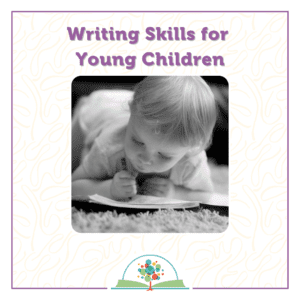04 Oct Writing Skills for Young Children
Writing Starts Early!
Learning to write is part of early literacy, and the process begins with the first intentional movements of a baby’s hand. Over time, babies learn how to reach for things, touch things, and pick up things. As children grow, they try to understand the world. Their understanding of writing leads them from touching their finger to something, to scribbling, to scribbling that looks more like writing, to forming letters and numbers. As they progress, they also learn that every letter has a sound, and that sounds can be written down with letters.
Along with Read, Sing, Talk, and Play, Write is part of Every Child Ready to Read, a research-based approach to early literacy skills that we use to develop programs and activities at PGTPL. Sometimes caregivers aren’t sure how to incorporate writing skills into their young child’s every day life. Encouraging a child’s scribbles helps lead them to readiness for both reading and writing. They’ll build finger strength, learn how to hold a pencil, build the hand-eye coordination to move a pencil where they want, learn how to form the lines and curves of letters, and finally write letters.
Want to Know More?
If you’d like to read more about this, try How Do I Write…? on the Reading Rockets website. Although written with preschool teachers in mind, there’s a good description of scribbling in babies and toddlers.
Practical Ideas to Try
With Babies:
- A dab of food like pudding or yogurt may lead to your child spreading it around on their high chair tray. Yes, this helps develop writing skills! So does picking up bits of food like cheerios or peas.
- Ask your child to tell you about what they’re writing when they scribble. Even if your baby just jabbers, respond in a back-and-forth conversation so they can start to get the idea that talking bounces between people.
- Squeeze play dough to build fine motor skills.
With Toddlers:
- Shaving cream in a sealed plastic bag is a great way to practice emerging. A few drops of food coloring makes it even more fun. Taping the plastic bag down makes it easier for your child. This is also an excellent and fun activity for older children at other stages of writing.
- Start writing and naming letters. For example, show a capital M by tracing up, down, up down and connecting the words and sound: “That’s M. Mmmmm. Mmm for Maria, that’s you!”
- Make sure your child has access to writing materials like blank paper and thick crayons.
- Fingerpainting and painting with big craft brushes reinforce creativity and pre-writing skills.
Books You Might Enjoy

Andrew Draws by David McPhail
Andrew’s scribbles with a crayon he found become better and better until he is making drawings so realistic that they come right off the page.

Little Plane learns to write by practicing his skywriting. Engage your child by tracing the letters as Little Plane writes them!

A young boy wants to write a story, just like his big sister. But there’s a problem, he tells her. Though he knows his letters, he doesn’t know many words.
From Peas to Pencils
Help your young child by giving them fun opportunities to develop their pre-writing skills. So much of what they do in their everyday life builds these skills—from peas to pencils. Give them the opportunity to create with paper and crayons and watch them learn!





